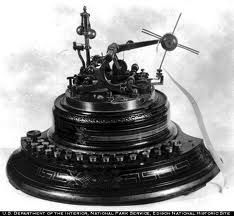Parody news announces “smart rice cooker” by KDDI, KDDI goes ahead and begins designing it
Master Blaster
On 13 November, a tweet went out from Kyoko Shimbun which read “AAAAAAAAAAAAA!” Generally, such single-letter interjections don’t yield much of a response, but in this case they got over 400 retweets.That’s because on this day, Kyoko Shimbun which translates to “Fabricated News” learnt that their fictional Infojar, a next-gen rice cooker with several smartphone capabilities, was in the research and development phase by the very company they were spoofing at the time, KDDI.
■ Fake Infojar
In the fake announcement published back in January of this year, Kyoko Shimbun explained that due to each of Japan’s major mobile providers now carrying the iPhone, KDDI’s brand au would have to find another niche to fill. So, they decided to enter the rice cooker market.
11/15/2014 archive
Nov 15 2014
Random Japan
Nov 15 2014
Health and Fitness News
 Welcome to the Stars Hollow Gazette‘s Health and Fitness News weekly diary. It will publish on Saturday afternoon and be open for discussion about health related issues including diet, exercise, health and health care issues, as well as, tips on what you can do when there is a medical emergency. Also an opportunity to share and exchange your favorite healthy recipes.
Welcome to the Stars Hollow Gazette‘s Health and Fitness News weekly diary. It will publish on Saturday afternoon and be open for discussion about health related issues including diet, exercise, health and health care issues, as well as, tips on what you can do when there is a medical emergency. Also an opportunity to share and exchange your favorite healthy recipes.
Questions are encouraged and I will answer to the best of my ability. If I can’t, I will try to steer you in the right direction. Naturally, I cannot give individual medical advice for personal health issues. I can give you information about medical conditions and the current treatments available.
You can now find past Health and Fitness News diaries here and on the right hand side of the Front Page.
Follow us on Twitter @StarsHollowGzt

Andrew Scrivani for The New York Times
If you haven’t started thinking about vegetarian main dishes for Thanksgiving, now is the time. This year I am focusing on beans from North America. I have been enjoying a number of heirloom beans native to the Southwest and Mexico, and they were the inspiration for these dishes, most of which also incorporate other foods native to the Americas – squash, corn, potatoes, sweet potatoes, tomatoes. [..]
Although I’m loving the heirloom beans I’ve discovered, they are not a requirement for any of this week’s recipes. The pintos, black beans, white beans and red beans in your local supermarket will be fine. But it does pay to use dried beans rather than canned, so that you get the delicious savory broth along with the perfectly seasoned beans.
A vegan dish that is slightly sweet and spicy. This new world bean dish will satisfy the vegetarians and vegans at the Thanksgiving table.
Refried Black or Pinto Bean, Zucchini and Corn Gratin
An interpretation of a traditional Southwestern dish with three distinct layers.
A substantial vegetarian Thanksgiving main dish.
Thanksgiving Mixed Bean Chile With Corn and Pumpkin
A straightforward vegetarian chili that is a favorite throughout the year.
White Tepary Bean and Potato Purée
A side dish that can be a comforting, high-protein substitute for mashed potatoes.
Nov 15 2014
On This Day In History November 15
This is your morning Open Thread. Pour your favorite beverage and review the past and comment on the future.
November 15 is the 319th day of the year (320th in leap years) in the Gregorian calendar. There are 46 days remaining until the end of the year.

On this day in 1867, On this day in 1867, the first stock ticker is unveiled in New York City. The advent of the ticker ultimately revolutionized the stock market by making up-to-the-minute prices available to investors around the country. Prior to this development, information from the New York Stock Exchange, which has been around since 1792, traveled by mail or messenger.
The ticker was the brainchild of Edward Calahan, who configured a telegraph machine to print stock quotes on streams of paper tape (the same paper tape later used in ticker-tape parades). The ticker, which caught on quickly with investors, got its name from the sound its type wheel made.
Calahan worked for the Gold & Stock Telegraph Company, which rented its tickers to brokerage houses and regional exchanges for a fee and then transmitted the latest gold and stock prices to all its machines at the same time. In 1869, Thomas Edison, a former telegraph operator, patented an improved, easier-to-use version of Calahan’s ticker. Edison’s ticker was his first lucrative invention and, through the manufacture and sale of stock tickers and other telegraphic devices, he made enough money to open his own lab in Menlo Park, New Jersey, where he developed the light bulb and phonograph, among other transformative inventions.
Stock tickers in various buildings were connected using technology based on the then-recently invented telegraph machines, with the advantage that the output was readable text, instead of the dots and dashes of Morse code. The machines printed a series of ticker symbols (usually shortened forms of a company’s name), followed by brief information about the price of that company’s stock; the thin strip of paper they were printed on was called ticker tape. As with all these terms, the word ticker comes from the distinct tapping (or ticking) noise the machines made while printing. Pulses on the telegraph line made a letter wheel turn step by step until the right letter or symbol was reached and then printed. A typical 32 symbol letter wheel had to turn on average 15 steps until the next letter could be printed resulting in a very slow printing speed of 1 letter per second. In 1883, ticker transmitter keyboards resembled the keyboard of a piano with black keys indicating letters and the white keys indicating numbers and fractions, corresponding to two rotating type wheels in the connected ticker tape printers.
Newer and more efficient tickers became available in the 1930s and 1960s but the physical ticker tape phase was quickly coming to a close being followed by the electronic phase. These newer and better tickers still had an approximate 15 to 20 minute delay. Stock ticker machines became obsolete in the 1960s, replaced by computer networks; none have been manufactured for use for decades. However, working reproductions of at least one model are now being manufactured for museums and collectors. It was not until 1996 that a ticker type electronic device was produced that could operate in true real time.
Simulated ticker displays, named after the original machines, still exist as part of the display of television news channels and on some World Wide Web pages-see news ticker. One of the most famous displays is the simulated ticker located at One Times Square in New York City.
Ticker tapes then and now contain generally the same information. The ticker symbol is a unique set of characters used to identify the company. The shares traded is the volume for the trade being quoted. Price traded refers to the price per share of a particular trade. Change direction is a visual cue showing whether the stock is trading higher or lower than the previous trade, hence the terms downtick and uptick. Change amount refers to the difference in price from the previous day’s closing. These are reflected in the modern style tickers that we see every day. Many today include color to indicate whether a stock is trading higher than the previous day’s (green), lower than previous (red), or has remained unchanged (blue or white).
Nov 15 2014
The Breakfast Club (Poppies!)
 I must have space on my mind this week, as well as Remembrance Day.
I must have space on my mind this week, as well as Remembrance Day.
The Planets (Op. 32) is a 7 movement suite for a large orchestra. How large? Two Piccolos, 4 Flutes, an Alto Flute, 3 Oboes, a Bass Oboe, an English Horn, 3 Clarinets, a Bass Clarinet, 3 Bassoons, and a Contrabassoon. Six French Horns, 4 Trumpets, 2 Trombones, a Bass Trombone, a Euphonium, and a Tuba. Six Timpani, a Bass Drum, a Snare Drum, Cymbals, a Triangle, a Tam-Tam, a Tamborine, a Xylophone, a Glockenspiel, and Tubular Bells. A Celesta and an Organ. Two Harps. Your usual compliment of 1st and 2nd Violins, Violas, Cellos, and Double Basses.
Oh and two (count ’em) two Three Part Women’s Choruses (two Sopranos and an Alto), located in an adjoining room thank goodness because there’s hardly any place to put them on stage.
The 7 movements are supposed to be evocative of, what else, the planets. Can you spot the ones that are missing?
- 00:00 Mars, the Bringer of War
- 07:21 Venus, the Bringer of Peace
- 15:58 Mercury, the Winged Messenger
- 20:14 Jupiter, the Bringer of Jollity
- 27:50 Saturn, the Bringer of Old Age
- 37:12 Uranus, the Magician
- 43:15 Neptune, the Mystic
Why Earth silly, and also Pluto which wasn’t discovered until March 13, 1930.
Now Holst despite his German sounding name (Gustav) was actually 2nd generation British, his Grandfather Gustavus having emigrated from Latvia in 1802. As an early 20th century composer he’s perhaps best described as post-Romantic of the Folk Music vein. He actually admired Wagner (idiot) and would have done much better sticking to his earlier Idol, Arthur Sullivan. As is typical of the 20th century school he could and did write in many of the established musical forms (Symphonies for instance), but didn’t feel bound by them. He was a big fan of Henry Purcell and was frequently inspired by poetry rather than nature, a post-Romantic trend, and by Folk Music (a late Romantic trend), a sublimation of the jingoistic nationalism of much Romantic Music. He was also impressed with Hindu mysticism and did several of his own translations from Sanskrit and wrote a few pieces based on the Ramayana and the Mahabharata, a more 20th century sort of thing. Perhaps his best musical friend was Vaughan Williams who was arguably the most influential British composer of the 20th century. Holst was “traditional” in that he was not nearly as interested as some of his contemporaries in flouting convention just for the sake of it.
The Planets, his most successful work, was written between 1914 and 1916, and received it’s first performance in 1918, just before he left for Salonica to work with British veterans waiting to be demobilized. He had frequently volunteered for military service but was rejected because of his chronic asthma. Several of his relatives, friends, and musical acquaintances did serve and a few of them died.
When I listen to this piece, especially the movements related to the Inner Planets (Mars, Venus, and Mercury), I often think of the Great War and speculate about whether the music was effected by contemporary events. Traditional music history though suggests that the motivation was astrological and the movements reflective of the influence of the planets on the psyche.
This particular recording is the Berliner Philharmoniker under the direction of Karajan and has some nice pictures from NASA.
As for astrology?
The fault, dear Brutus, is not in our stars, but in ourselves, that we are underlings.
–Julius Caesar (I, ii, 140-141)
Obligatories, News and Blogs below.
Nov 15 2014
Party at SHG-That Reminds Me
This week at the Party we’re going to do something a little different. Instead of telling you what theme to post to, you tell me something. You tell me what the song you’re posting reminds you of or makes you think about. Okay? Okay!
This one reminds me of being 14 or 15 years old and sleeping out in the summertime, and running around the neighborhood at night. Mostly just meeting up with our friends, smoking, and playing cards, but our moms would have been plenty pissed off.


Recent Comments